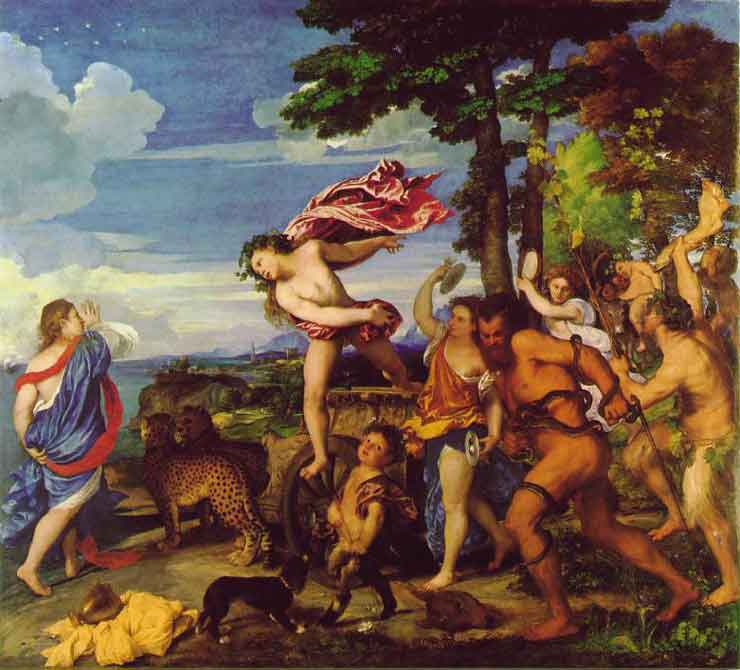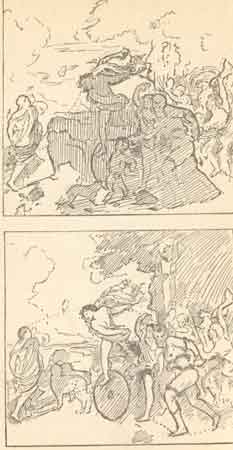|
|

Bacchus and Ariadne of
SOLOMON J. SOLOMON :
The canvas is an unusually square one. The main upper line of the groups is convex-an arc- which in the rough outline sketch is indicated by the arrow-heads, which describe also the general convexity of the base line. The secondary lines flow to the curves of the crowning drapery. The dots indicate their course, on the one hand starting from the folds of the flying drapery, curving through the right arm of Bacchus, along the arm of the satyr with the snakes, towards the centre, through his upper leg, to the lighted foot of the Bacchante, and so on to the dog. This line is picked up through the arms and back of the hinder satyr, taken through the upheld leg of the calf ; it then descends across the small Silenus, and again up through the curved arm with the tambourine. On the Ariadne side there is a moral connection between the crowning lines and the folds of the blue dress, which are turned the reverse way and upwards, to the hand that gathers them. The central group as a mass-detached from the Ariadne and the back figures-is shaded in the sketch, and is pyramidal in its generalised outline, and within that mass is another beautiful shape marked by the oblique shaded lines, of the group made up of the snake-charmer, the Bacchante with the timbrels, the little satyr, and the dog ; extended towards the bronze vase. Let us try to appreciate the part the little satyr plays. Firstly, without him the picture would be cut in two, and the perpendicular made by the tree, the uplifted arm with the timbrel, and the lighted leg of the central Bacchante, would check the forward movement into the picture, and there would be a somewhat objectionable block contained within its boundary and the upright of the frame. Now what does our little friend do? He conducts this recalcitrant group across the Rubicon, and, aided by the light fold of the golden drapery that flaps out behind his little head, he becomes part of the foreground group of three, amplifying and thereby beautifying its form. And again, without his assistance and that of his adjuncts, the hase of the picture would be concave, which at all hazards had to be avoided. You will see in diagram B, sketched without him, that not only is such concavity weak, but that here it repeats throughout the arc of the upper line- which is still more objectionable ! The little fellow, however, comes along with his calf's head and his barking dog, and the difficulty of the base line is removed ; and then he cuts through the chariot wheel, which, were he not in front of it, would be an almost isolated curve too near the centre of the composition. Titian was no doubt jubilant when the inspiration of the little imp came to him ; and that must account for its joyous handling. The satyr with the raised calf's hock and the fat Silenus against his head, made beautiful by his pattern, not only lift up the line that would otherwise descend too symmetrically, but add the note of accident which makes for the gaiety and movement of the picture. When a figure in a composition moves as the Bacchus does, everything has to move. One unresponsive figurant would be enough to spoil the party. The foreshortened pointing arm of Bacchus conducts all the lines into the picture-a subtle and satisfying factor. His descending foot cuts well through the wheel. Were this foot only to meet the upper curve, its owner would never alight, but would appear to be standing on it. Apart from helping to distract attention 'from the arc of the main group, let us see what is the function of the Bacchante with the tambourine. Her arm doubles the line of the group in front of her, thus enriching it. She is a connecting link that takes the eye on to the distant Silenus, thereby adding fresh planes to the grouping ; and her echoing of the timbrels gives to the picture the music that is in it, for one musician would hardly impress us as a very full orchestra. The trees are finely disposed ; the foliage against the sky directs the eye towards Ariadne, and the doubling of the stems imparts a fulness. One alone, like the single musician, would not be satisfying. The cumulus cloud on the left carries over in a similar manner to the foliage the interest from the other side of the canvas. All shapes should make a pleasant pattern, whether in their silhouettes or in the masses left between them. See how beautiful is the passage of sky between the arm of Bacchus and the tree. By comparing the half-tone reproduction with the outline sketch, you will see more clearly the importance of the arbitrary shadows and tones- those, for instance, across the leopards whose forms are merged into the shadowed background ; and with reason, for had they been fully lighted and clearly outlined, they would have arrested attention and spoilt the tête-à-tête between the chief actors. Just those passages in the picture have been illuminated where the eye is asked to wander, the rest being discreetly shaded. The little isolated white cloud aids the arc and the agitation, and the sweeping horizontals divide up into a decorative pattern the otherwise heavy mass of blue sky. JOHN BURNET: Reynolds says, " The conduct of Titian in this picture has been much celebrated, and justly, for the harmony of colouring. To Ariadne is given (say the critics) a red scarf, to relieve the figure from the sea, which is behind her. It is not for that reason alone, but for another of much greater consequence; for the sake of the general harmony and effect of the picture. The figure of Ariadne is separated from the great group, and is dressed in blue, which, added to the colour of the sea, makes that quantity of cold colour which Titian thought necessary for the support and brilliancy of the great group; which group is composed, with very little exception, entirely of mellow colours. But as the picture in this case would be divided into two distinct parts, one half cold, and the other warm, it was necessary to carry some of the mellow colours of the great group into the cold part of the picture, and a part of the cold into the great group; accordingly Titian gave Ariadne a red scarf, and to one of the Bacchante a little blue drapery." If a diagonal line be drawn across the picture, we find the picture composed of a mass of hot and a mass of cold colours, laid out upon the broadest scale, and aiding each other by their opposition. The blue is carried into the warm mass by a little blue drapery, and a few blue flowers at the bottom of the picture; the next approach from the cool to the warm colours is by green, produced by the green of the distance and the trees; and is carried on to the figures by the wreaths of vine tendrils, &c., and repeated by the grass at the bottom. The warm colour is brought up against the cool ground by the drapery of Bacchus, which is of a lake colour, and the scarf of Ariadne of a strong red ; which latter coming in contact with her blue drapery, attracts the eye by its harsh opposition, this figure being the point from which the action of the picture emanates. We find in this arrangement not only the greatest breadth of colour, but also such colour laid out in the general appearance of nature. When we compare Titian with other colourists, we find in his tones a greater truth and sweetness, his deepest brown shadows never appear black, his reds have a less harsh appearance from their being less positive, his green colours less violent, possessing more tone either of a brown or gray hue, and his deepest blues truer to the colouring of nature in extreme distances, or in the deep blue of the sky, or in distant sea.
See also The Worship of Venus, c. 1519 Bacchus and Ariadne, c. 1520/3 (C) Venus Anadyomene, c. 1525 Venus and Amor with the Organ Player Sisyphus, 1548/9 Perseus and Andromeda, 1554/6 Diana and Callisto, 1556/9 The Death of Actaeon , c. 1562 The Rape of Europa, 1559/62
 |
|
||||||||||||||

